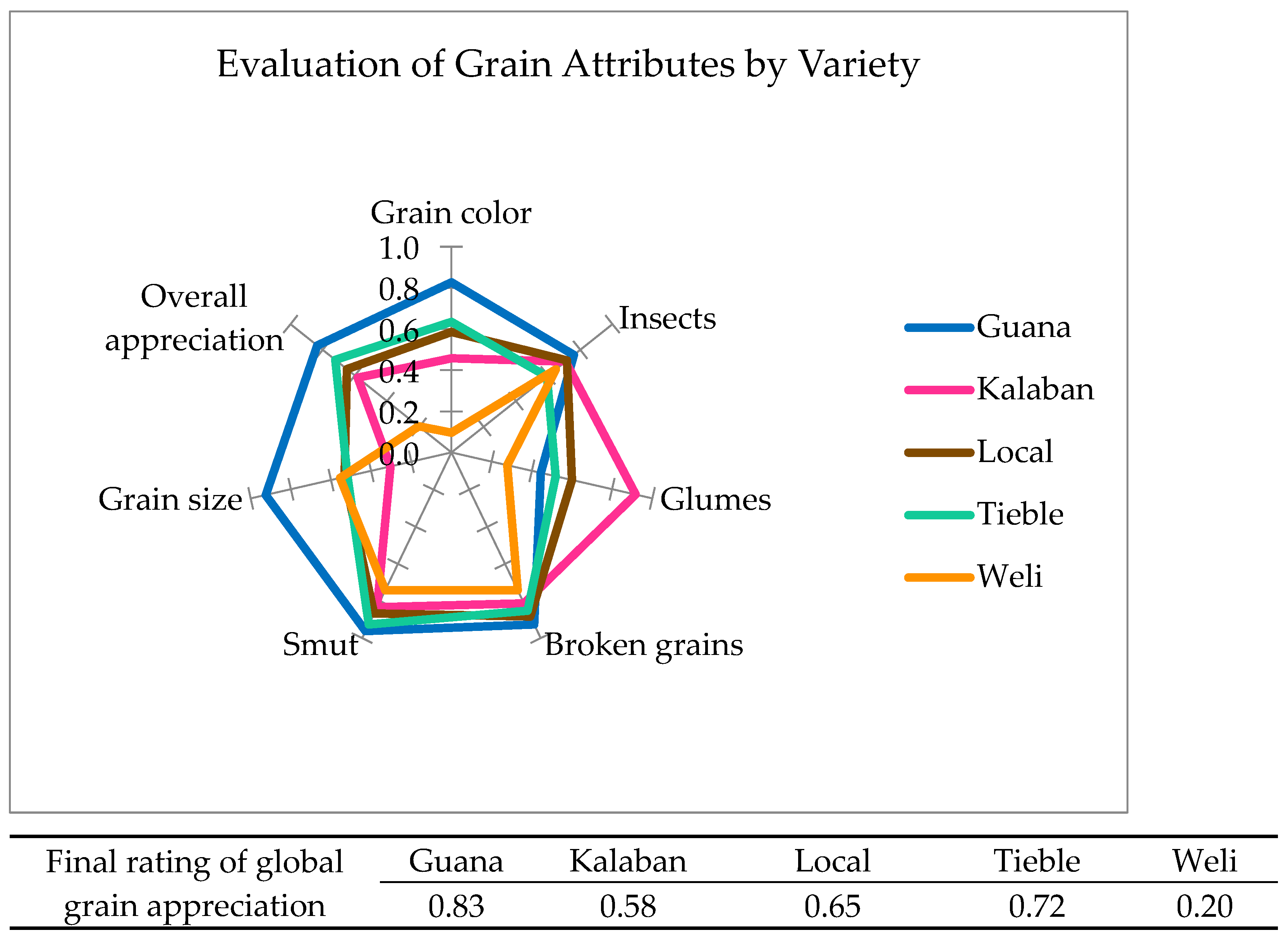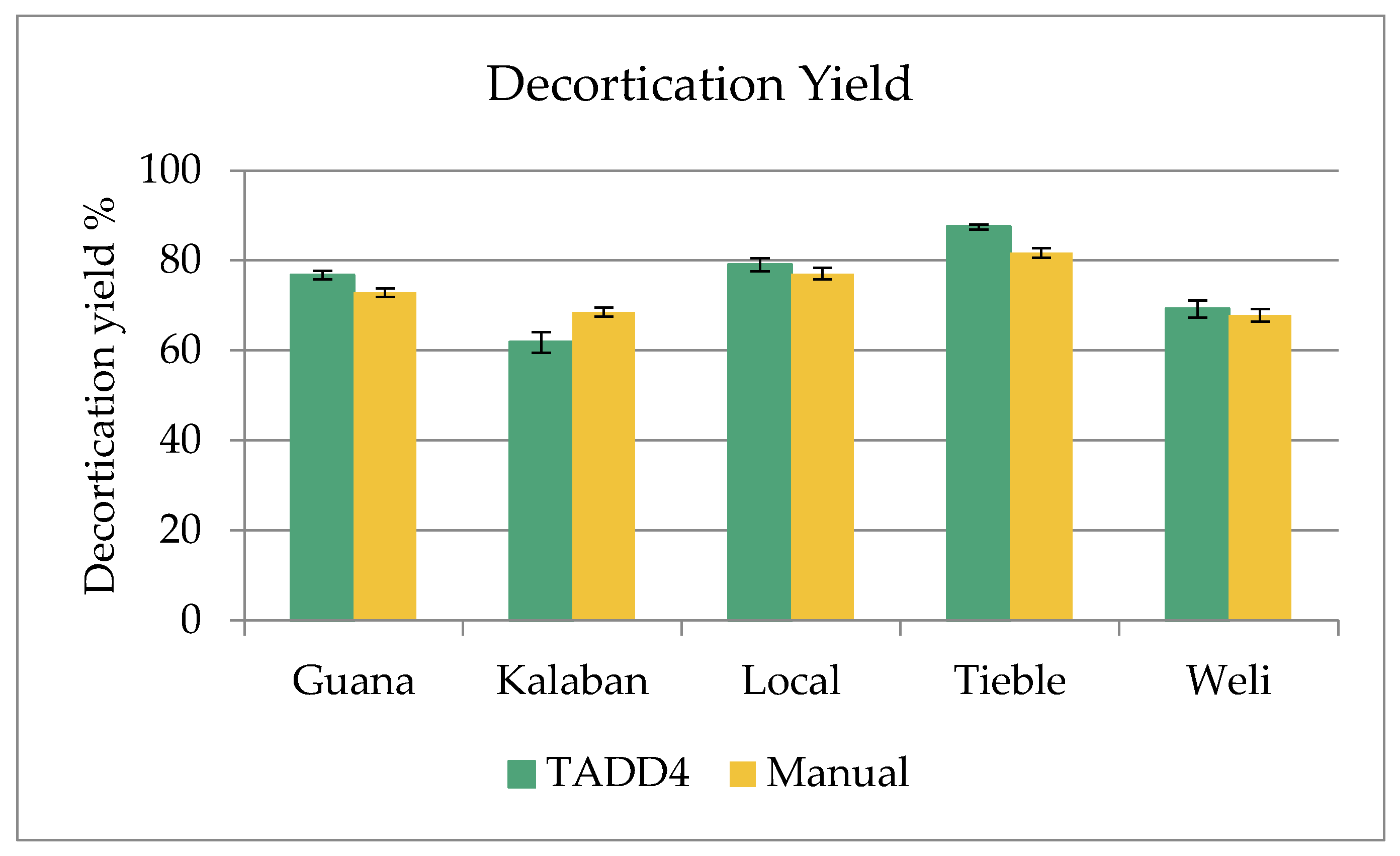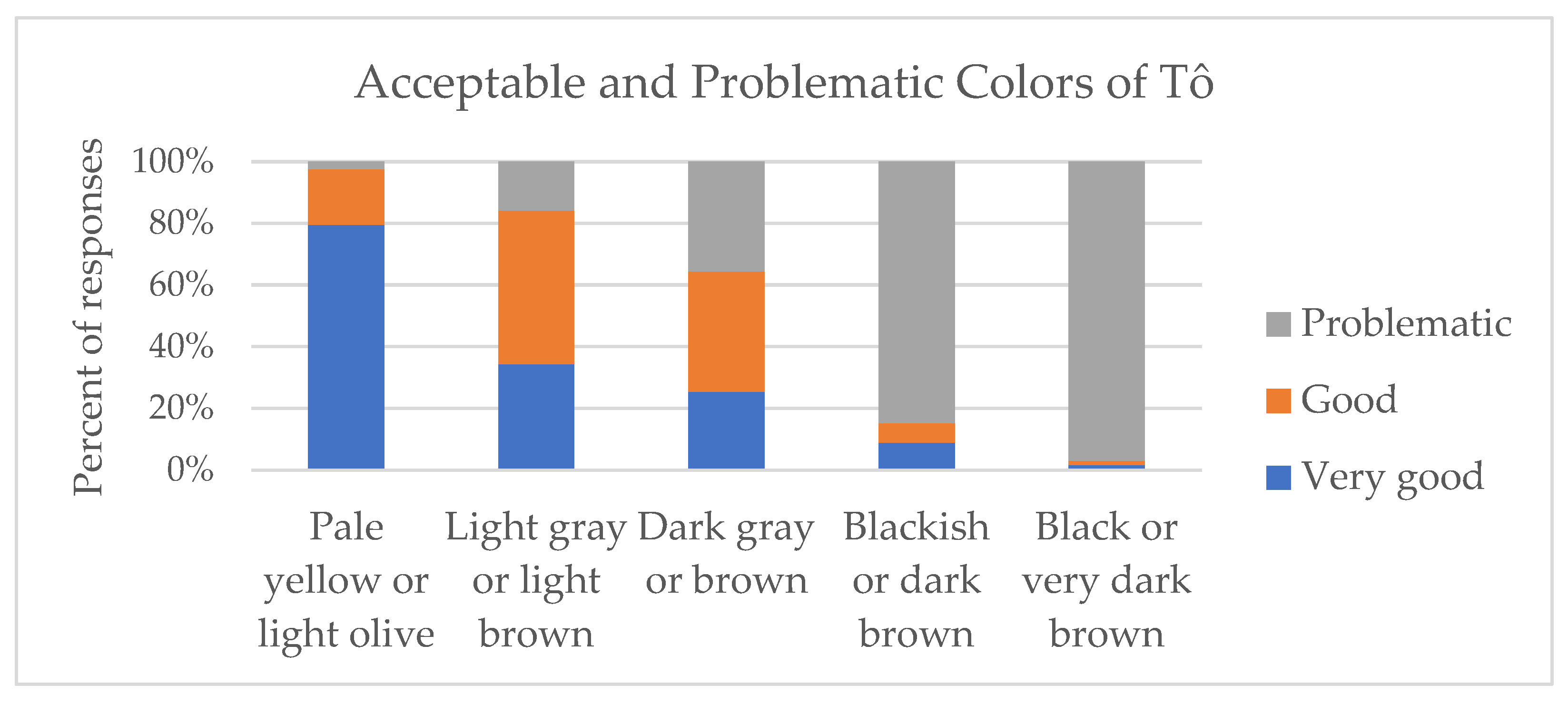Participatory Evaluation of Sorghum Processing and Sensory Attributes in Mali: Methodology for Improving Food Security Outcomes from Variety Development Efforts
Abstract
1. Introduction
2. Materials and Methods
2.1. Study Area and Participants
2.2. Sorghum Varieties
2.3. Team
2.4. Culinary Test Design
2.5. Stages of Evaluation
2.6. Laboratory Grain Analysis
2.7. Statistical Analysis
3. Results
3.1. Participation
3.2. Grain Attributes
3.3. Decortication Yield
3.4. Evaluations by Women during Grain Processing, Tô Preparation and Conservation
3.5. Village Sensory Evaluations
3.6. Linking Lab and Field
3.7. Effectiveness of Methodology
3.7.1. Differences between the Repetitions
3.7.2. Difference between Men and Women, Villages and Zones
4. Discussion
4.1. Assessing Varietal Differences for Grain Characteristics
4.2. Assessing Varietal Differences for Organoleptic Qualities
4.3. Methodological Options for Effective Culinary Testing
5. Conclusions
Author Contributions
Funding
Acknowledgments
Conflicts of Interest
Appendix A
| Characteristics | Scores | |
| Analysis in village by women and men | ||
| 1. Grain characteristics | Grain color Presence of insects Glumes Broken grains Grain size Smut Overall appreciation | 1 = Poor 2 = Good 3 = Very good |
| Humidity | Percent | |
| 2. Decortication | Ease of decortication Grain color after decortication | 1 = Poor 2 = Good 3 = Very good |
| Water used during decortication | Milliliter | |
| Weight of decorticated grains Weight of bran | Gram | |
| Duration of decortication | Minutes | |
| 3. Grinding | Ease of grinding Impression of color of flour Coarseness of flour Hardness of breaking Global evaluation of grinding | 1 = Poor 2 = Good 3 = Very good |
| Weight of flour Weight of broken pieces | Gram | |
| Duration of grinding | Minutes | |
| 4. Preparation of tô | Meal savings Impression of color of tô Texture of tô Global evaluation of tô | 1 = Poor 2 = Good 3 = Very good |
| Potassium used Water used | Milliliter | |
| Weight of unused flour Weight of tô | Gram | |
| Color of tô | ||
| 5. Sensory evaluation | Taste Color Texture (consistency) Global evaluation | 1 = Poor 2 = Good 3 = Very good |
| 6. Conservation of tô | Taste Color Texture (conservation) Global appreciation | 1 = Poor 2 = Good 3 = Very good |
| Field analysis by technician | ||
| 1. Color of tô | 1 = Yellow, olive green (very good) 2 = Bright grey or bright brown 3 = Bit dark grey or brown 4 = Blackish or dark brown (bad color) 5 = Black or very dark brown (very bad color) | |
| 2. Texture of tô (measured the next morning) | 1 = Very consistent 2 = Consistent 3 = Soft 4 = Sodden 5 = Very sodden | |
| Laboratory analyses | ||
| 1000-kernel weight % of grains attacked by anthracnose % of grains attacked by moisture % of dis-colored whole grains % of dis-colored decorticated grains Pericarp thickness Presence of testa Vitreousness of grain Decortication yield (TADD) Ease of decortication (TADD) % of broken grains (TADD) % of broken grains (manually decorticated) | ||
References
- Weltzien, E.; Rattunde, H.F.W.; van Mourik, T.A.; Ajeigbe, H.A. Sorghum Cultivation and Improvement in West and Central Africa. In Achieving Sustainable Cultivation of Sorghum: Sorghum Utilization around the World; Rooney, W., Ed.; Burleigh Dodds Science Publishing Limited: Cambridge, UK, 2018; pp. 217–240. ISBN 978-1-78676-124-8. [Google Scholar]
- Orr, A.; Weltzien, E.; Rattunde, F. Research and Development for Sorghum and Millets in Sub-Saharan Africa: What Have We Learned? Outlook Agric. 2022, 51, 435–447. [Google Scholar] [CrossRef]
- Siart, S. Strengthening Local Seed Systems: Options for Enhancing Diffusion of Varietal Diversity of Sorghum in Southern Mali; Kommunikation und Beratung: Weikersheim, Germany, 2008; ISBN 978-3-8236-1525-5. [Google Scholar]
- Yapi, A.M.; Kergna, A.O.; Debrah, S.K.; Sidibe, A.; Sanogo, O. Analysis of the Economic Impact of Sorghum and Millet Research in Mali; International Crops Research Institute for the Semi-Arid Tropics: Patancheru, India, 2000; ISBN 9789290664192. [Google Scholar]
- Sperling, L.; Berkowitz, P. Partners in Selection: Bean Breeders and Women Bean Experts in Rwanda; CGIAR: Washington, DC, USA, 1994. [Google Scholar]
- Sperling, L.; Ashby, J.; Weltzien, E.; Smith, M.; McGuire, S. Others Base-Broadening for Client-Oriented Impact: Insights Drawn from Participatory Plant Breeding Field Experience. In Broadening the Genetic Bases of Crop Production; CAB International: Wallingford, UK, 2001; pp. 419–435. [Google Scholar]
- vom Brocke, K.; Trouche, G.; Weltzien, E.; Barro-Kondombo, C.P.; Gozé, E.; Chantereau, J. Participatory Variety Development for Sorghum in Burkina Faso: Farmers’ Selection and Farmers’ Criteria. Field Crops Res. 2010, 119, 183–194. [Google Scholar] [CrossRef]
- Sissoko, M.; Smale, M.; Castiaux, A.; Theriault, V. Adoption of New Sorghum Varieties in Mali Through a Participatory Approach. Sustainability 2019, 11, 4780. [Google Scholar] [CrossRef]
- Diallo, C.; Isaacs, K.; Gracen, V.; Touré, A.; Weltzien Rattunde, E.; Danquah, E.Y.; Sidibé, M.; Dzidzienyo, D.K.; Rattunde, F.; Nébié, B.; et al. Learning from Farmers to Improve Sorghum Breeding Objectives and Adoption in Mali. J. Crop Improv. 2018, 32, 829–846. [Google Scholar] [CrossRef]
- Gitau, P.W.; Kunyanga, C.N.; Abong, G.O.; Ojiem, J.O.; Muthomi, J.W. Assessing Sensory Characteristics and Consumer Preference of Legume-Cereal-Root Based Porridges in Nandi County. J. Food Qual. 2019, 2019, 3035418. [Google Scholar] [CrossRef]
- Aboubacar, A.; Kirleis, A.W.; Oumarou, M. Important Sensory Attributes Affecting Consumer Acceptance of Sorghum Porridge in West Africa as Related to Quality Tests. J. Cereal Sci. 1999, 30, 217–225. [Google Scholar] [CrossRef]
- Ghebrehiwot, H.M.; Shimelis, H.A.; Kirkman, K.P.; Laing, M.D.; Mabhaudhi, T. Nutritional and Sensory Evaluation of Injera Prepared from Tef and Eragrostis Curvula (Schrad.) Nees. Flours with Sorghum Blends. Front. Plant Sci. 2016, 7, 1059. [Google Scholar] [CrossRef] [PubMed]
- Teeken, B.; Garner, E.; Agbona, A.; Balogun, I.; Olaosebikan, O.; Bello, A.; Madu, T.; Okoye, B.; Egesi, C.; Kulakow, P.; et al. Beyond “Women’s Traits”: Exploring How Gender, Social Difference, and Household Characteristics Influence Trait Preferences. Front. Sustain. Food Syst. 2021, 5, 490. [Google Scholar] [CrossRef]
- Weltzien, E.; Rattunde, F.; Sidibe, M.; Vom Brocke, K.; Diallo, A.; Haussmann, B.; Diallo, B.; Nebie, B.; Toure, A.; Christinck, A. Long-Term Collaboration between Farmers’ Organizations and Plant Breeding Programmes: Sorghum and Pearl Millet in West Africa. In Farmers and Plant Breeding; Westengen, O.T., Winge, T., Eds.; Routledge: Oxfordshire, UK, 2019; pp. 29–48. ISBN 978-0-429-50733-5. [Google Scholar]
- Isaacs, K.; Weltzien, E.; Diallo, C.; Sidibe, M.; Diallo, B.; Rattunde, F. Farmer Engagement in Culinary Testing and Grain-Quality Evaluations Provides Crucial Information for Sorghum Breeding Strategies in Mali. In State of the Knowledge for Gender in Breeding: Case Studies for Practitioners; CGIAR Gender and Breeding Initiative: Ethiopia, Addis Ababa, 2018; Volume 3. [Google Scholar]
- Voss, R.C.; Donovan, J.; Rutsaert, P.; Cairns, J.E. Gender Inclusivity through Maize Breeding in Africa: A Review of the Issues and Options for Future Engagement. Outlook Agric. 2021, 50, 392–405. [Google Scholar] [CrossRef] [PubMed]
- Fliedel, G. Evaluation de la qualité du sorgho pour la fabrication du tô. Agric. Développement 1994, 4, 12–21. [Google Scholar]
- Teeken, B.; Olaosebikan, O.; Haleegoah, J.; Oladejo, E.; Madu, T.; Bello, A.; Parkes, E.; Egesi, C.; Kulakow, P.; Kirscht, H.; et al. Cassava Trait Preferences of Men and Women Farmers in Nigeria: Implications for Breeding. Econ. Bot. 2018, 72, 263–277. [Google Scholar] [CrossRef] [PubMed]
- Howard, P.L. (Ed.) Women and Plants: Gender Relations in Biodiversity Management and Conservation; Zed Books: New York, NY, USA; Eschborn, Germany, 2003; ISBN 978-1-84277-157-0. [Google Scholar]
- Weltzien, E.; Rattunde, F.; Christinck, A.; Isaacs, K.; Ashby, J. Gender and Farmer Preferences for Varietal Traits. In Plant Breeding Reviews; John Wiley & Sons, Ltd.: Hoboken, NJ, USA, 2019; pp. 243–278. ISBN 978-1-119-61680-1. [Google Scholar]
- Galiè, A. When ‘Do No Harm’ Is Harder than ‘Doing Good.’ ILRI News 2018. Available online: https://news.ilri.org/2018/08/07/when-do-no-harm-is-harder-than-doing-good/ (accessed on 1 December 2022).
- Asante, S.A. Sorghum Quality and Utilization. 1995. Available online: https://tspace.library.utoronto.ca/handle/1807/20761 (accessed on 1 December 2022).
- Lykke, A.M.; Mertz, O.; Ganaba, S. Food Consumption in Rural Burkina Faso. Ecol. Food Nutr. 2002, 41, 119–153. [Google Scholar] [CrossRef]
- House, L.R. A Guide to Sorghum Breeding; International Crops Research Institute for the Semi-Arid Tropics: Patancheru, India, 1985. [Google Scholar]




| Zone and Village | Participants | Local Variety | Experimental Varieties Tested in All Villages | ||
|---|---|---|---|---|---|
| Women | Men | ||||
| Mandé | Kenièro | 15 | 10 | Segetana | Kalaban (00 KO-F5DT-19) Guana (GP00*IS15401_K4) Weli (GPN01 S01 267-9-1) Tieblé (CSM335) |
| Teneya | 10 | 15 | Niobleni | ||
| Siranikoro | 6 | 19 | Keleyabomousso | ||
| Siby | 15 | 10 | Troukani | ||
| Dioila | Kafla | 10 | 15 | Niobleni | |
| Magnambougou | 10 | 15 | Bandokablen | ||
| Tonga | 12 | 13 | Niobleni | ||
| Seyla | 12 | 13 | Segetana | ||
| Seribila | 11 | 14 | Kassorokoro | ||
| 225 Total Participants | 101 | 124 | |||
| Name | Pedigree | Race | Panicle Type | Plant Pigmentation | Plant Height | Mean Yield in Trial Villages (2005 and 2006) (t/ha) |
|---|---|---|---|---|---|---|
| Kalaban | 00 KO-F5DT-19 | Caudatum | semi-compact | Tan | intermediate | 1.7 t/ha |
| Guana | GP00*IS15401_K4 | Interracial | semi-compact | Pigmented | tall | 1.4 t/ha |
| Weli | GPN01 S01 267-9-1 | Interracial | semi-lax | Pigmented | intermediate | 1.5 t/ha |
| Tieble | CSM335 | Guinea | lax | Pigmented | tall | 1.4 t/ha |
| Local * | Local Varieties | Guinea | lax | Pigmented | tall | 1.3 t/ha |
| Mean Preference Scores by Processors | |||||
|---|---|---|---|---|---|
| Variety | Grain Score * | Decortication Ease | Grinding Ease | Ease of Tô Preparation | Tô Conservation |
| Guana | 0.83 | 0.80 | 0.74 | 0.65 | 0.67 |
| Kalaban | 0.54 | 0.37 | 0.80 | 0.76 | 0.83 |
| Tieble | 0.72 | 0.44 | 0.80 | 0.83 | 0.72 |
| Weli | 0.20 | 0.63 | 0.24 | 0.24 | 0.39 |
| Local ** | 0.69 | 0.48 | 0.70 | 0.65 | 0.67 |
| Variety | Grain Color | Preference Score | Color of Tô | Preference Score |
|---|---|---|---|---|
| Guana | White (cream) | 0.83 | Grey or brown (bright) | 0.55 |
| Kalaban | Yellow (tan) | 0.46 | Yellow or olive green | 0.93 |
| Tieble | Brown, red flecks | 0.63 | Grey or brown (bright) | 0.68 |
| Weli | White, red/grey flecks | 0.10 | Black or dark brown | 0.03 |
| Variety | Color | Taste | Consistency | Global | Total |
|---|---|---|---|---|---|
| Guana | 0.55 | 0.67 | 0.63 | 0.61 | 2.46 |
| Kalaban | 0.93 | 0.74 | 0.66 | 0.75 | 3.08 |
| Local * | 0.58 | 0.63 | 0.60 | 0.56 | 2.38 |
| Tieble | 0.68 | 0.72 | 0.65 | 0.66 | 2.71 |
| Weli | 0.02 | 0.58 | 0.67 | 0.28 | 1.56 |
| Source | d.f. | Deviance | Mean deviance | Deviance ratio | Chi pr. |
| Regression | 30 | 3359 | 111.977 | 111.98 | <0.001 |
| Residual | 3297 | 3721 | 1.128 | ||
| Total | 3327 | 7080 | 2.128 |
| Variety | Score | Color | Consistency | Taste |
|---|---|---|---|---|
| Guana | Problematic | 0.60 | 0.59 | 0.76 |
| Good | 0.70 | 0.63 | 0.59 | |
| Very good | 0.63 | 0.84 | 0.93 | |
| Kalaban | Problematic | 0.05 | 0.71 | 0.88 |
| Good | 0.21 | 0.55 | 0.49 | |
| Very Good | 0.94 | 0.74 | 0.92 | |
| Local * | Problematic | 0.46 | 0.68 | 0.71 |
| Good | 0.69 | 0.53 | 0.59 | |
| Very Good | 0.66 | 0.85 | 0.92 | |
| Tieble | Problematic | 0.33 | 0.69 | 0.73 |
| Good | 0.68 | 0.59 | 0.53 | |
| Very Good | 0.74 | 0.84 | 0.90 | |
| Weli | Problematic | 1.00 | 0.36 | 0.49 |
| Good | 0.04 | 0.27 | 0.30 | |
| Very Good | 0.09 | 0.91 | 0.96 | |
| Overall, across varieties | Problematic | 0.71 | 0.50 | 0.62 |
| Good | 0.54 | 0.54 | 0.52 | |
| Very Good | 0.72 | 0.82 | 0.92 |
| Laboratory | Field | Correlation Coefficient | p Value |
|---|---|---|---|
| 100-seed weight | Seed size appreciation | 0.599 | <0.001 |
| % of discolored grain | Grain color appreciation | −0.437 | <0.001 |
| Mechanical decortication yield | Manual decortication yield | 0.622 | <0.001 |
| Vitreosity score | Manual decortication yield | 0.486 | <0.001 |
| Grain hardness | % of broken grains following manual decortication | −0.495 | <0.001 |
Disclaimer/Publisher’s Note: The statements, opinions and data contained in all publications are solely those of the individual author(s) and contributor(s) and not of MDPI and/or the editor(s). MDPI and/or the editor(s) disclaim responsibility for any injury to people or property resulting from any ideas, methods, instructions or products referred to in the content. |
© 2023 by the authors. Licensee MDPI, Basel, Switzerland. This article is an open access article distributed under the terms and conditions of the Creative Commons Attribution (CC BY) license (https://creativecommons.org/licenses/by/4.0/).
Share and Cite
Isaacs, K.; Smit, M.; Samaké, B.; Rattunde, F.; Cissé, F.; Diallo, A.; Sidibe, M.; Weltzien, E. Participatory Evaluation of Sorghum Processing and Sensory Attributes in Mali: Methodology for Improving Food Security Outcomes from Variety Development Efforts. Sustainability 2023, 15, 4312. https://doi.org/10.3390/su15054312
Isaacs K, Smit M, Samaké B, Rattunde F, Cissé F, Diallo A, Sidibe M, Weltzien E. Participatory Evaluation of Sorghum Processing and Sensory Attributes in Mali: Methodology for Improving Food Security Outcomes from Variety Development Efforts. Sustainability. 2023; 15(5):4312. https://doi.org/10.3390/su15054312
Chicago/Turabian StyleIsaacs, Krista, Marjolein Smit, Bakary Samaké, Fred Rattunde, Fatimata Cissé, Abdoulaye Diallo, Mamourou Sidibe, and Eva Weltzien. 2023. "Participatory Evaluation of Sorghum Processing and Sensory Attributes in Mali: Methodology for Improving Food Security Outcomes from Variety Development Efforts" Sustainability 15, no. 5: 4312. https://doi.org/10.3390/su15054312
APA StyleIsaacs, K., Smit, M., Samaké, B., Rattunde, F., Cissé, F., Diallo, A., Sidibe, M., & Weltzien, E. (2023). Participatory Evaluation of Sorghum Processing and Sensory Attributes in Mali: Methodology for Improving Food Security Outcomes from Variety Development Efforts. Sustainability, 15(5), 4312. https://doi.org/10.3390/su15054312






